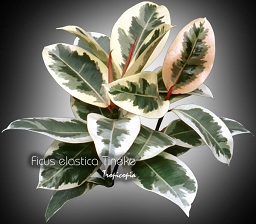Table of contents
Rubber plant

Latin Name: Ficus elastica ‘Tineke’
Category: Ficus
Family: Moraceae
Origin: Cultivar
Climate: Tropical
Growing Zones: 11-10
Care Instructions
The Rubber plant (Ficus elastica ‘Tineke’) is a tropical plant that originates from Cultivar. This ficus plant belongs to the Moraceae family and is well-suited for growing in USDA zones 11-10.
Complete Care Guide for Rubber Plant (Ficus elastica ‘Tineke’)
Watering Requirements
The Rubber Plant (Ficus elastica ‘Tineke’) thrives with a balanced watering routine. It is essential to allow the top inch of soil to dry out between waterings. Overwatering can lead to root rot, a common issue with this plant. During the growing season (spring and summer), water the plant thoroughly, ensuring that excess water drains out of the pot’s bottom. In the fall and winter months, reduce watering frequency as the plant enters a dormant phase. Always check the moisture level by sticking your finger into the soil; if it feels dry, it’s time to water. Additionally, using room temperature water can help prevent shock to the roots.
Light Conditions
Rubber Plants prefer bright, indirect light but can adapt to lower light conditions. Ideally, place your Ficus elastica ‘Tineke’ near a window that receives filtered sunlight. Direct sunlight can scorch the leaves, while too little light can hinder growth and lead to leggy stems. If you notice the leaves losing their vibrant variegation or becoming dull, it may be a sign that the plant needs more light. Rotate the plant occasionally to ensure even growth and prevent it from leaning towards the light source.
Soil Preferences
The ideal soil for a Rubber Plant is a well-draining potting mix that retains some moisture without becoming soggy. A blend of potting soil, perlite, and orchid bark works well to provide aeration and drainage. It’s crucial to ensure that the pot has drainage holes to prevent water accumulation. Fertilization should be done during the growing season with a balanced, water-soluble fertilizer every 4-6 weeks. In the fall and winter, reduce or stop fertilization as the plant’s growth slows down. Always follow the manufacturer’s instructions for dilution rates to avoid fertilizer burn.
Pests and Diseases
Common pests that may affect the Rubber Plant include spider mites, mealybugs, and scale insects. Regularly inspect the leaves for any signs of infestation, such as webbing or sticky residue. If pests are detected, treat the plant with insecticidal soap or neem oil, ensuring to cover both the tops and undersides of the leaves. Additionally, keep the humidity levels moderate, as dry conditions can encourage pest problems. Diseases such as leaf spot and root rot can occur if the plant is overwatered or if there is poor air circulation. To prevent these issues, ensure proper watering practices and provide adequate spacing between plants for airflow.
Special Care Tips
To maintain the health and beauty of your Rubber Plant, consider the following special care tips: regularly wipe the leaves with a damp cloth to remove dust and enhance photosynthesis. This also helps to prevent pest infestations. If your plant becomes too tall or leggy, you can prune it back to encourage bushier growth. Propagation is also possible through stem cuttings, which can be rooted in water or soil. Lastly, be mindful of temperature; Rubber Plants prefer temperatures between 60°F and 75°F (15°C to 24°C) and should be protected from drafts and sudden temperature changes. With proper care, your Ficus elastica ‘Tineke’ will thrive and add a touch of elegance to your indoor space.








